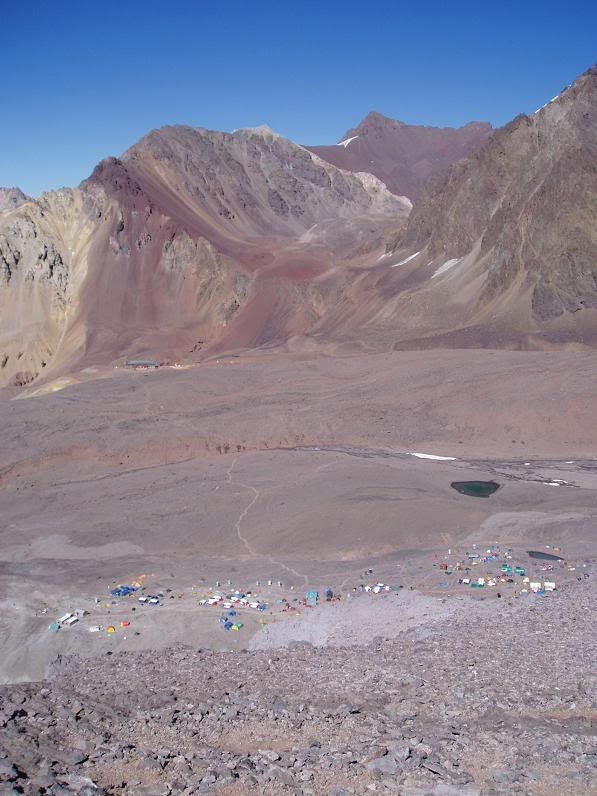
Plaza de Mulas with main base camp in foreground, hotel in distance and on horizon Cerro Bonete
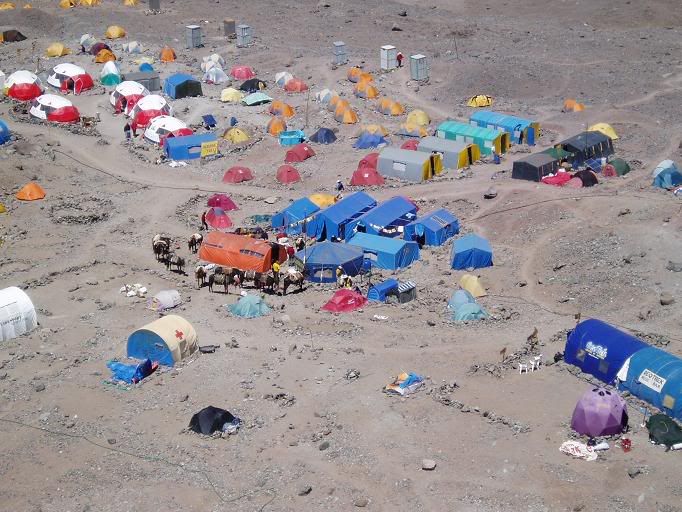
Campo Base base camp - several dorm tents, orange dining tent and octagonal cook tent
I visited the doctors in the morning - compulsory before you try to climb Aconcagua. They were very thorough, and were almost falling over themselves to dish out medication to anyone with the slightest sniffle. My back and neck were aching which I suspect was rucksack, rather than altitude, related. At altitude the body takes at least several days to adjust to the thin air, and there is a consequent increase in blood pressure, pulse rate and decrease in percentage oxygen saturation of the blood (SpO2). My vital statistics were - Pulse - 100, B.P. 140/90, SpO2 - 83%. Considering normal SpO2 is 98-99%, I was glad to be walking; my value however was about average in the group.
The other essential at altitude is to drink, drink and drink. You need to drink 4-5 litres of water a day to cope properly; when in the afternoon the "juice" that they serve is half full of sediment it gets pretty hard to inbibe your quota.
At 4260m the temperature rarely gets into double figures in the day.The sun is extremely strong and can burn within minutes due to a much thinner layer of atmosphere to protect from UV rays. So during the day, out of the cold wind, you can sit in long sleeved tops and trousers and feel fairly comfortable. The minute the sun sets, however, the temperature plunges below zero and everything begins to freeze.
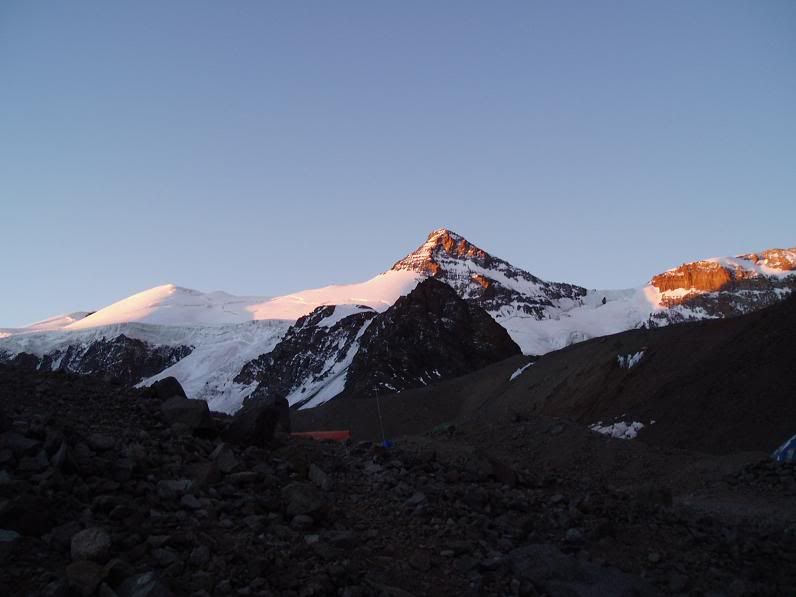
Sunset over Cerro Cuerno, north of base camp
Here the stuff we had sent up from the hostel came in handy - down jackets, fleece trousers and all manner of expensive North Face items. The average night time temperature was probable -5 to -10 degrees, helped by an invariably cloudless night sky filled with southern constellations - an upside down Orion, the Southern Cross, and a couple of huge nebulae.
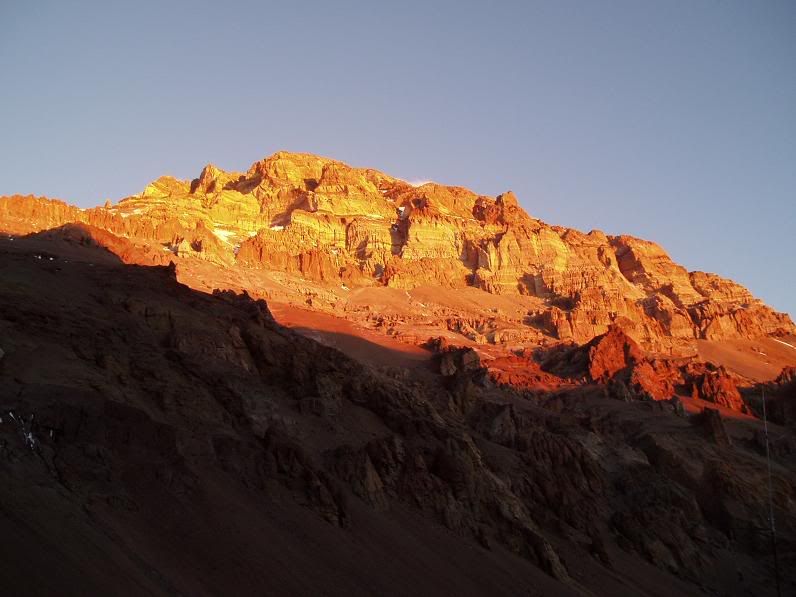
Sunset over the west face of Aconcagua
On the 3rd of February the plan was to walk up Cerro Bonete, a 4900m peak to the west of base camp that would help with acclimatision process. I woke with a splitting headache and feeling nauseous; after forcing down some breakfast and Ibuprofen I felt a lot better. Accompanying our group was our guide, Apu, plus Xavier, manager of the Campo Base staff who was very friendly and patient. On the way we went past the base camp hotel before starting the slow climb up to the top - a long slog of about 3 hours in total. From the top there were excellent views of the west face of Aconcagua that towers over Plazas de Mulas base camp, plus a range of views in every other direction. Unfortunately Paco couldn't make it to the top - he was having a harder time than the rest of us adjusting to the altitude. Altitude sickness is not something that you can predict will occur - it can happen to the fittest or the most unfit or people with equal regularity. Some bodies adjust quicker to the altitude, others don't seem able to.

West face of Aconcagua from the slopes of Cerro Bonete
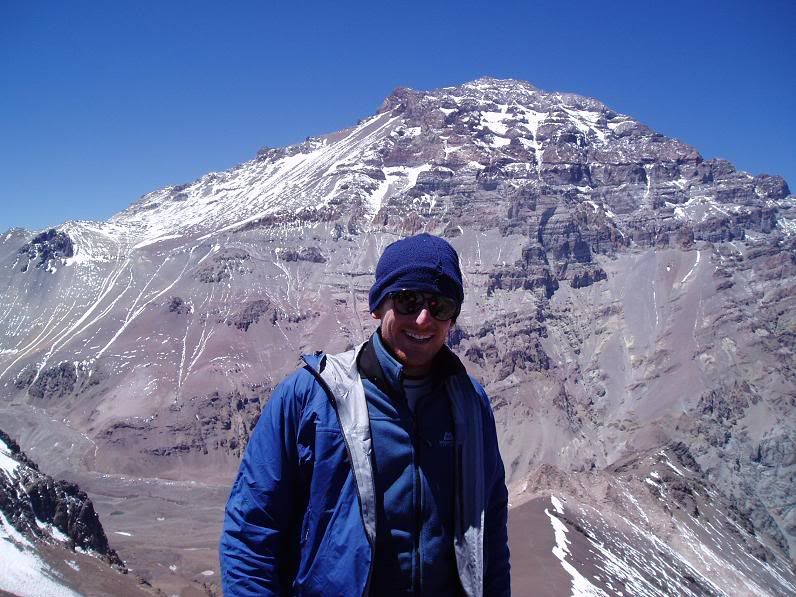
Yours truly on top of Cerro Bonete; Aconcagua in background
The descent from the Cerro was great fun but an ecologist's nightmare. Lack of vegetation means most slopes are just scree runs that become terribly eroded as soon as any group of 14 pass by on them. On return to camp I shelled out $5 for a hot shower - my first in a week. It felt lovely, but I didn't get the chance to shave, so my baby beard continued to grow. I also changed my clothes for the first time - nice.
The 4th of February was another rest day, and another trip to the doctors. My SpO2 had increased to 84%, my B.P. was the same and my pulse was 91. I was improving. And I even washed some clothes - albeit in the mud-laden meltwater off the glacier.
The plan for the next day way a porterage up to Nido de Condores, the camp at 5200m which is the lowest height at whihch you can begin a summit attempt. It's almost 1km higher than Plaza de Mulas, although not far as the crow flies - basically a long slow slog up the lower slopes of Aconcagua. Most people carried with them further equipment they wouldn't use in base camp - crampons, extra gloves and hats, plastic walking boots and the like. We also had to carry some food and fuel for the stoves already up at Nido. I decided to test out my (hired) plastic boots - these basically consist of an inner thermally lined boot which then inserts into a rigid plastic shell - on a par with ski boots but a little more flexible. They become necessary at higher altitudes in extreme cold and when there is snow and ice to walk on in crampons.
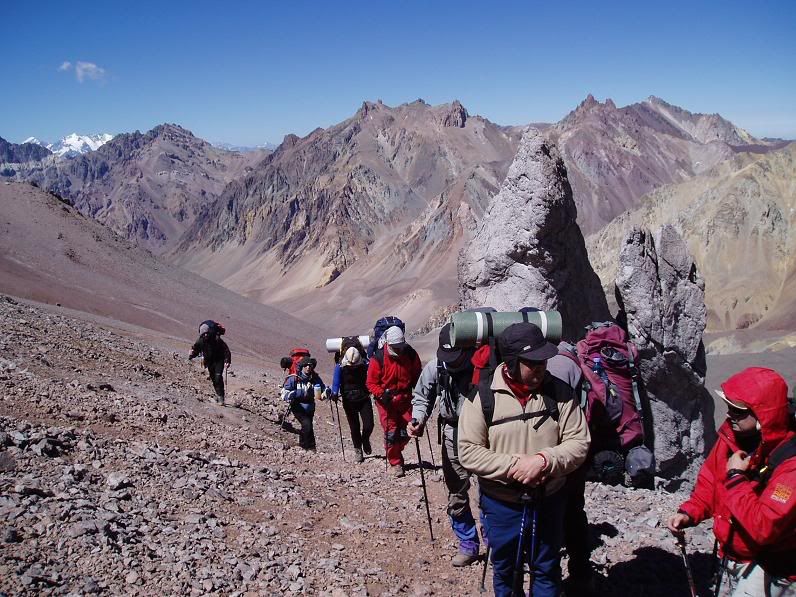
The group at Piedras Conway, on the way up to Nido
Xavier left early in the morning for Nido to carry a further load of food up, before descending again to accompany our group back up. He had to do this so that Apu, our guide, could run up to Berlin camp at 5900m and bring down tents we could put up. On the way up we passed Plaza Canada, an intermediate level camp at 4700m or so.
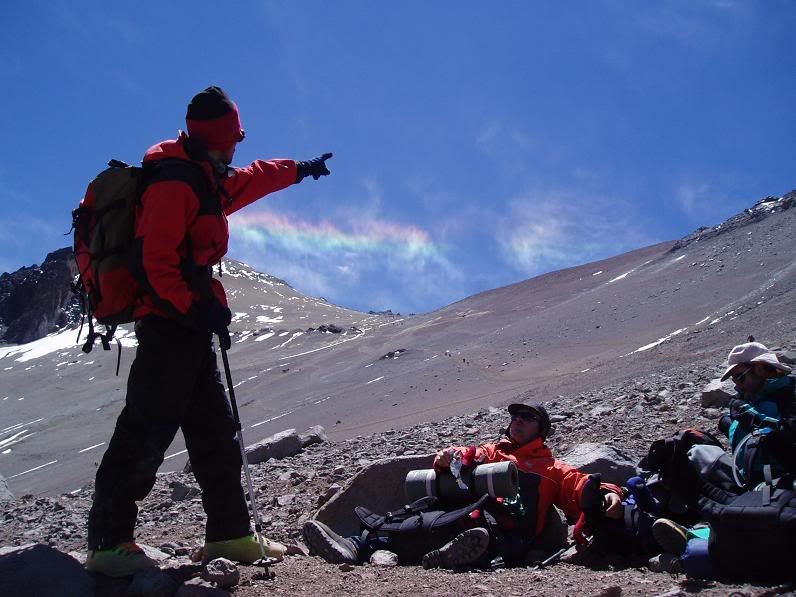
View up the hill from Plaza Canada, Xavier pointing out salient features of the mountain
We reached Cambio de Pendiente at lunch, about 5000m. I had another splitting headache and and was feeling sick again - probably altitude related. Paco was again unable to make it higher than Plaza Canada. The rest of us were feeling out of breath with each step, a feeling that got worse once we reached Nido and started putting up tents. My favourite part of the day was the descent - another erosion nightmare, but great if you like scree running (even if it is in plastic boots).
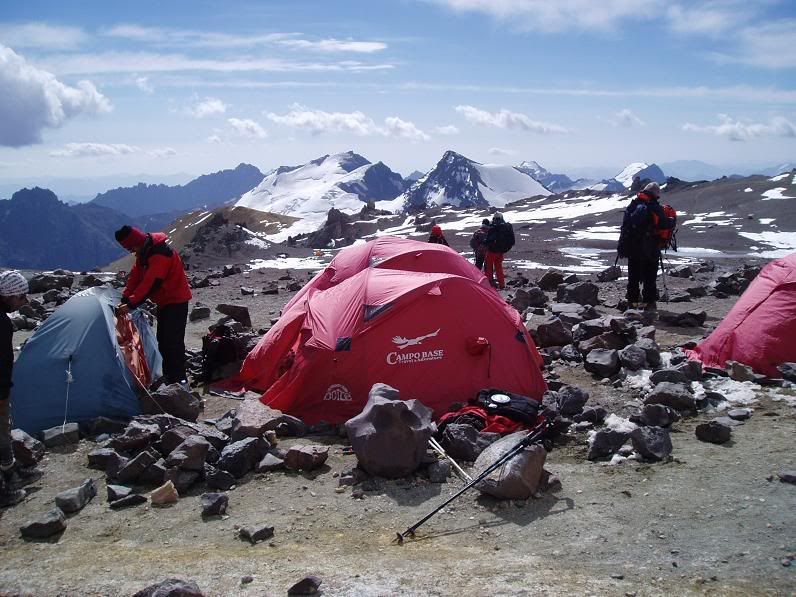
The camp at Nido de Condores
Dinner that evening was pretty good, despite the fact that Xavier had climbed the equivalent of 2km vertical height. I bumped into some other Brits on a Jagged Globe expedition - after 10 days of Spanish only it was a bit strange speaking in the mother tongue.
The 6th was a rest day, well earned after the exercise of yesterday. My main activity of the day was sleeping, punctuated by eating and a visit to the doctors - Pulse 85, B.P. 120/80, SpO2 87%. This exceeded the requisite 85% needed to attempt the summit, so all in all I was the picture of health! This has to be taken relatively - every night you get a blocked nose and congested sinuses, breath cold mountain air through your mouth that becomes rapidly dries followed by your tongue drying and cracking.
Originally the 7th was planned as the first day of the summit attempt, but several members of the group were a little under the weather so we had an extra rest day - my visit to the doctors (again) confirmed my good health and readiness for the summit. In the late morning four of us went for a quick 1 hour blast up to Piedras Conway, some 250m above Plaza de Mulas on the way to Nido.
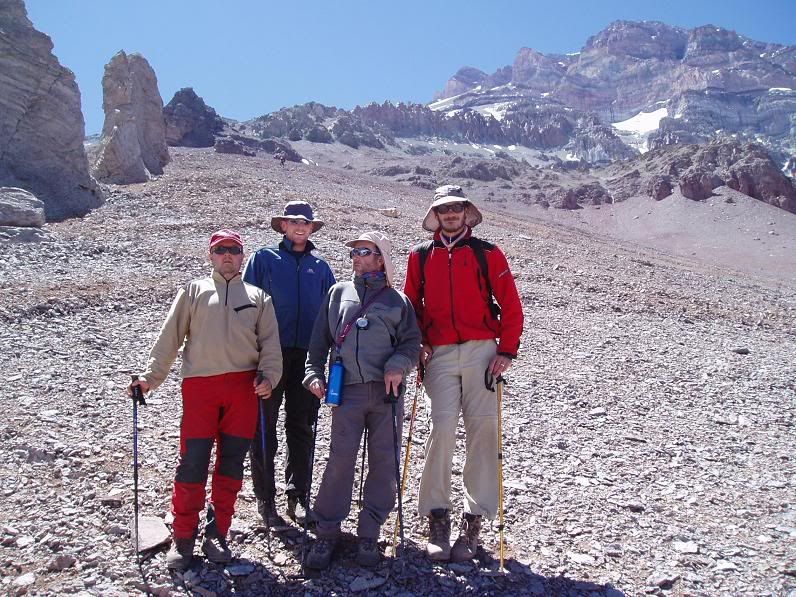
At Piedras Conway for the second time; Aconcagua in background
With a possible change in the weather on the way, the 8th way set as the day on which we hwould have to begin the summit attempt.

2 comments:
C'mon pete - we want the final post! Great read, and am forwarding in mail to Granny. Please no swearing! Take care, Dave.
I'm exhausted reading this-our acclimatisation for our trip to Machu Picou seems easy now! Fab photos. Best wishes for the ascent-Mrs Fish
Post a Comment